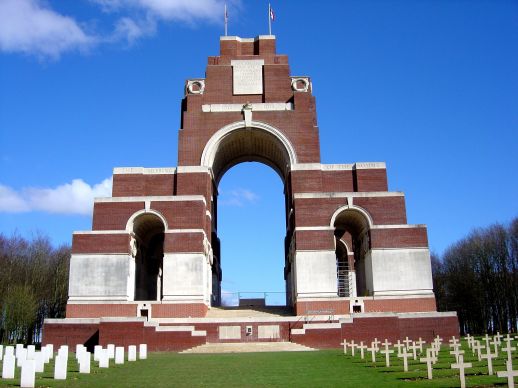John Gill
Date of birth: 1894
Date of death: 22.7.1916
Area: Outwood
Regiment: King's Own Yorkshire Light Infantry
Family information: Son of Walter and Mary Gill of Leeds Road, Outwood
Rank: Corporal
Service number: 200295 (1572)
War Service
On mobilisation, the 4th Battalion, later to become 1/4th KOYLI, moved to Doncaster, where the 1st West Riding Brigade, 1st West Riding Division, was assembling. From the 26th February 1915, the battalion was based at York, where it remained until proceeding overseas to join the British Expeditionary Force. On 13th April, Private John Gill, No.1572, along with the 1/4th Battalion, KOYLI left York by train for Folkestone, from where they sailed to Boulogne.
On 28th April, the 1/4th KOYLI entered the line near Fleurbaix in the Bois Grenier. The following month the 1st West Riding Brigade, was designated 148th Infantry Brigade, 49th (West Riding) Division
On 9th July 1915, the 49th Division, moved into the sector between Ypres and Boesinghe, which was the left flank of the British Army line in Flanders. Throughout the summer, the men of the 49th Division were engaged in constructing and repairing trenches and strong points, which were constantly shelled by the enemy artillery.
At 05.00 hours on 19th December, when 1/4th KOYLI was in the front line trenches, the enemy released Chlorine gas over the front line. The men deployed in the front line were immediately alert to the danger and successfully stopped incursions by the enemy patrols. At 06.15 hours, when the 1/4th Battalion were being relieved, the enemy laid down a bombardment, using shells filled with Phosgene gas. This was the first time this type of gas had been used. Such was the concentration of Phosgene that the helmets worn by the troops were not adequate, resulting in many casualties.
During the gas attacks and subsequent bombardments, Private Gill, a 1/4th KOYLI signaller, kept his line open to headquarters, remaining at his post for over seventeen hours. For his conspicuous devotion to duty at this time, Private John Gill was awarded the Distinguished Conduct Medal. He was also promoted to Corporal
During the spring of 1916, the 1/4th KOYLI, was used by the 112th Railway Construction Company near Acheux. This was followed by training near Villers-Bocage, for the forthcoming battle. On the 1st July 1916, the opening day of the battle of the Somme, the 49th (West Riding) Division was in Reserve. However, the 1/4th and 1/5th KOYLI battalions were placed at the disposal of the 96th Infantry Brigade. On the evening of 2nd July, the two battalions relieved units in the Thiepval sub-sector, taking over trenches captured the previous day. At dawn, on 3rd July the 1/4th KOYLI positions were bombarded for two hours, the enemy using high explosive and shrapnel shells. On the 5th July, companies from the 1/4th KOYLI were in support of an unsuccessful attack by the 1/5th KOYLI, when that battalion attempted to extend their positions in the “A” Line trenches. On 6th July, the 1/4th KOYLI relieved the 1/5th KOYLI, in the “A” Line trenches. At 02.00 hours on the 7th July, the enemy opened an intense bombardment on the 1/4th KOYLI positions in the “A” Line, resulting in numerous casualties. At 02.50 hours, enemy bombers attacked and there was heavy fighting with bombs until. 06.30 hours, when the forward companies, were forced to retire to the original British front line. At 09.30 hours the battalion was ordered to move back to their assembly trenches in Thiepval Wood and when relieved, moved back to Hedauville for reorganisation.
The 1/4th KOYLI did not return to the trenches until the 21st July, when they rejoined the 148th Brigade, deployed in the Leipzig Salient. At 02.15 hours on the 23rd July, part of the battalion was ordered into attack, with a view to extending the British position on the Leipzig Salient. Heavy casualties were suffered crossing "No Man's Land" and the 1/4th KOYLI was forced to retire. The enemy soon launched a counter-attack, bombing the trenches leading to British line, but were eventually driven back. However, the position was heavily shelled and on the 24th July, the battalion was withdrawn from the front line, having incurred 70 casualties.
Corporal John Gill was reported missing, presumed killed, on 22nd July 1916. His body was never identified and as a consequence, his name is inscribed on the Thiepval Memorial. This memorial bears the names of more than 72000 officers and men of the United Kingdom and South African forces, who died on the Somme sector and who have no known grave.
Family Life
John Gill, was born in February 1894 at Great Houghton, near Barnsley. He was the son of Walter and Mary Gill, who later moved to “Thornlea” First Avenue, Leeds Road, Outwood. On leaving school he obtained work at a nearby colliery and at the time war was declared, he was employed as a miner at Hickleton Main Colliery. He was also a member of the Wakefield Territorials, the 4th KOYLI., which was at summer camp near Whitby, at the beginning of August 1914.
 Thiepval Memorial
Thiepval Memorial

